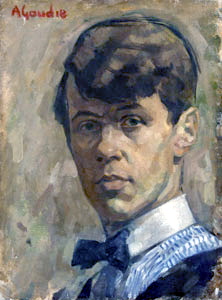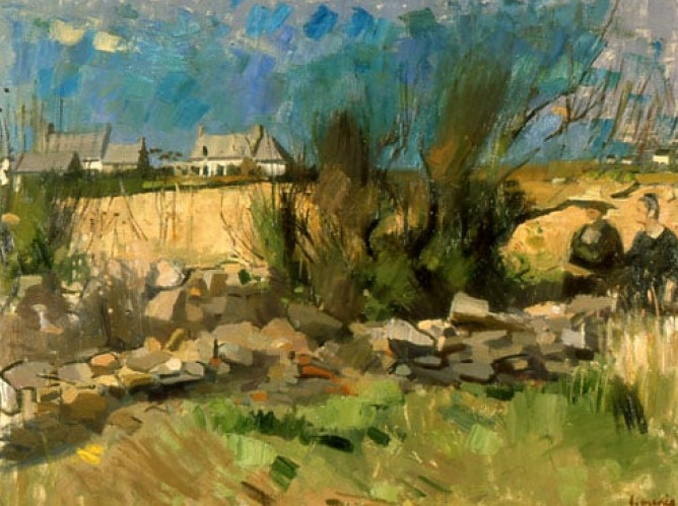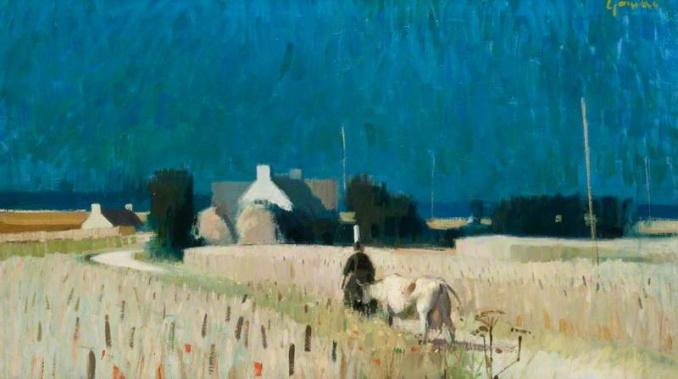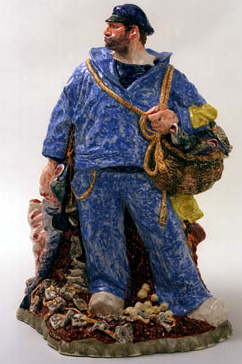Scottish Artist Alexander Goudie and His Love of Brittany

Scottish painter Alexander Goudie (11 November 1933 – 9 March 2004) was born in the town of Paisley (Scottish Gaelic: Pàislig) situated in the west central Lowlands of Scotland. He studied at the Glasgow School of Art under William Armour, David Donaldson and Benno Schotz and where he was awarded the Somerville Shanks Prize for Composition. The prize is named after William Somerville Shanks (28 September 1864 – 28 July 1951) a Scottish artist who was a tutor in painting and drawing at the Glasgow School of Art for 29 years. Alexander Goudie was a tutor at the school for a number years before dedicating himself to his own studio work. He is now widely acclaimed as having been one of Scotland’s finest figurative painters.
Amongst his considerable body of work there is a series of paintings depicting life and landscapes of the Celtic country of Brittany (Breton: Breizh). It was an interest that grew during his marriage to his Breton wife Marie-Renee Dorval. He documented the changing face of the Breton rural landscape in sketches and paintings over a 30 year period. In 1966 he staged his first exhibition of Breton paintings at The Scottish Gallery, Edinburgh, other exhibitions of Breton paintings at various galleries followed in 1986, 1987, 1992, 2002 and 2005.
In 1989 this culminated with the significant commission to decorate the interior of the Brittany Ferries Flagship, ‘Bretagne’. Later he was also chosen to revive the tradition of creative collaboration between artists and the famous ceramic ‘faienceries’ of Quimper. Quimper faience is produced in a factory near Quimper (Breton: Kempe) in Brittany. The resulting series of ceramic sculptures depicting ‘Breton types’, bear testament to a way of life that was rapidly changing by the end of the 20th century.

Alexander wrote about Brittany in this extract, courtesy of The Alexander Goudie Trust, taken from the essay ‘Goudie by himself’ in ‘Goudie’s Brittany’, which was published 1992:
“Unlike Gauguin, Serusier or Emile Bernard I did not seek out Brittany as a refuge from the more prosaic aspects of modern life. Nor was my going a conscious step, as it was in theirs, in developing a new and simple visual language midst a more fundamental culture. No, by the simple act of marriage I found myself an adopted son of a land strategic in the evolution of modern art, a secret garden where nature conspires in an endless drama! – A land of granite, a mighty ocean and a vast sky.
Here the players who tend this garden or venture out onto the wild seas that surround it, are cast in a similar mould. These stalwart characters, sun drenched and blasted by wind and rain, are as integral to the spectacle as the black and white cow or the cathedral-like, rose coloured cumulus that gathers up on the horizon. This splendid union of man and nature is further harmonized by a dazzling light which can lend humble, pastoral activity an epic grandeur; Jours de Fetes, Kermesse or Pardon when bathed in this light are elevated to pageants of theatrical splendour.

Nor is the heart left unmoved – what serious artist with any spiritual values could remain indifferent to the hard existence cruel nature exacts on the inhabitants of this often inhospitable peninsula. Aware of their temporal and vulnerable status, solace is found in religious ardour. The ubiquitous Calvaire or chapel spire, moss-covered and disfigured by the elements, silhouetted against grey stormy skies, testify to that devotion with touching eloquence. Only the windswept Tamaris which shares the dramatic skyline, hints at the stubborn defiance that also exists in the Breton spirit. Unsubdued by a cruel history – and proud of the fact – the poet in the Celtic soul allowed it to inspire a vigorous culture rich in folklore, music and art.

Only a mindless sceptic would not concede that fate had dealt me a generous hand. A whole way of life, picturesque and idyllic, lay before me; a visual feast, infinitely varied; from market place to kitchen table; from rural setting, where in the fields the peasant still toils, to the fishing port and the fisherman mending his nets. Here the reservoirs are replenished and here each year I commune with nature face to face – art after all can only be inspired by life and as Vincent Van Gogh once wrote to his brother Theo – “No one loves life more than artists”.
Since most of the year is spent working indoors, those annual visits are crucial - the lifestyle of a comparative recluse is exchanged for a much more gregarious existence. Here, as well as work there is living to be done and it has been my good fortune each summer to wed the two, hopefully to their mutual advantage. In any event, I have always lived through my art and in a sense to really taste life to the full I am obliged to put a line around it. Since early childhood this has been my lot, everything which excited my imagination had to be set down in pictorial terms, a magic world where a different language helps explore and explain as well as heighten the experience of living.
Alexander Goudie”
Although he held this passion for Brittany he was always proudly Scottish. Alexander Goudie held a fascination throughout his career with Robert Burns’ great narrative poem, ‘Tam O’Shanter’. This haunting tale by Scottish poet and lyricist Robert Burns (25 January 1759 – 21 July 1796) was first published in 1791. Much of the themes and imagery which the poet used were drawn from the local folk-lore of witchcraft which he learned from his childhood. Alexander Goudie re-created the poem in paintings. The final illustrative cycle of over 54 works, completed in 1996, would be purchased in its entirety and now resides on permanent public display at Rozelle House, near Burns’ home in Alloway, Ayrshire (Scottish Gaelic: Allmhaigh, Siorrachd Inbhir Àir).
- Scottish
- English





